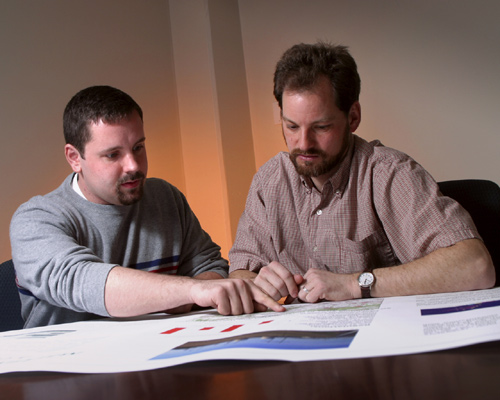When it comes to ensuring environmental safety, the answer may just be blowing in the wind for Kyle Moser ’06 (Pottstown, Pa.), who presented research this month at a national conference on the alleged export of pollution from Pennsylvania to New Jersey.
Along with two fellow Lafayette students, the civil engineering major has been examining airborne sulfur dioxide air drift around the power plant in Martins Creek, Pa., just north of Lafayette.
The case study, says Moser, was inspired by area newspaper stories in which residents from Warren County, N.J., who are downwind from the power plant complained about chemical emissions from the towers. Sulfur dioxide has been linked to asthma and other respiratory diseases, he says.
The residents believe that high asthma rates may be linked to the coal-fired Martins Creek power plant, which releases about 19,500 tons of sulfur dioxide per year. The residents and the New Jersey Department of Environmental Protection claim that prevailing winds blow the pollution from the power plant into New Jersey. In essence, says Moser, they allege that Pennsylvania is “exporting” its pollution.
Under the direction of David Brandes, assistant professor of civil and environmental engineering, the students used a passive sampling technique developed to test sulfur dioxide concentrations both upwind and downwind of the power plant. Ambient air samples indicated that the serious claims of the plant’s critics were not supported by scientific evidence of higher sulfur rates.
“From this data, we determined that there is not a significant difference in concentrations between the Pennsylvania and New Jersey sides of the Delaware River,” says Moser.
The tough part of the project, which began in the fall, was writing the report, he says. Moser’s colleagues are studying abroad in Brussels and they communicated via e-mail in composing their study. Moser made a presentation of their final paper at the 18th annual National Conference on Undergraduate Research, hosted April 15-17 by Indiana University-Purdue University at Indianapolis.
“Kyle is a very good student,” says Brandes. “He’s well-educated, hard-working, and motivated enough to work independently. [The students] had free rein on this study. It was pretty much their project and I am more than satisfied that they not only produced some solid test results, but they also learned how to work as a group, a situation they will face in the real world. We try to avoid casebook studies at Lafayette in favor of seeing our students tackle real-world problems, which is what Kyle did so well here in the study and in the group’s poster presentation.”
To experience first-hand research in the field is what Moser calls “a neat experience. Gaining hands-on experience, working with a faculty member up close, is something you never get at a larger school.”
A member of the student chapter of American Society of Civil Engineers and Lafayette Environmental Awareness and Protection, Moser says he takes a break from his “challenging academic studies” by playing club volleyball. This research project with Brandes, says Moser, only inspires him to pursue further student-based research in the future.
He is a graduate of Pottstown High School.
As a national leader in undergraduate research, Lafayette sends one of the largest contingents to the National Conference on Undergraduate Research each year. Forty-two students were accepted to present their work at the annual conference this month.

A National Leader in Undergraduate Research. Kyle Moser ’06 presented research on local pollution with David Brandes, assistant prof. of civil and environmental engineering, at the 18th National Conference on Undergraduate Research.
